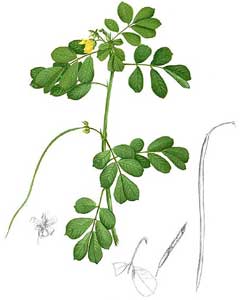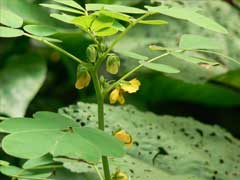 |
|
http://commons.wikimedia.org/wiki/File:Senna_tora_Blanco1.122-cropped.jpg |
 |
| fotopedia.com/flickr-1250292137 |
Translate this page:
Summary
Physical Characteristics

 Senna tora is a ANNUAL growing to 1 m (3ft 3in). It is in flower from May to June. The species is hermaphrodite (has both male and female organs).
Senna tora is a ANNUAL growing to 1 m (3ft 3in). It is in flower from May to June. The species is hermaphrodite (has both male and female organs).
Suitable for: light (sandy), medium (loamy) and heavy (clay) soils. Suitable pH: mildly acid, neutral and basic (mildly alkaline) soils. It can grow in semi-shade (light woodland) or no shade. It prefers moist soil.
UK Hardiness Map
US Hardiness Map
Synonyms
basionym: Cassia tora L.
Plant Habitats
Cultivated Beds;
Edible Uses
Edible Parts: Leaves
Edible Uses: Coffee
Young leaves - cooked as a vegetable[272]. Roasted seeds are a coffee substitute[272].
References More on Edible Uses
Medicinal Uses
Plants For A Future can not take any responsibility for any adverse effects from the use of plants. Always seek advice from a professional before using a plant medicinally.
Anthelmintic Anticholesterolemic Antispasmodic Carminative Febrifuge Hepatic Leprosy Ophthalmic
Parasiticide Purgative
The leaves and the seeds are anticholesterolemic, antispasmodic, carminative, emollient, hepatic, ophthalmic and purgative[51, 147, 176, 272, 279]. The powdered leaves are used in the treatment of indigestion and stomach pain[272].The leaves are used externally in the treatment of skin diseases[146, 272]. The seed contains anthraquinones and naphthopyrones[279]. It is anthelmintic, antibacterial, antifungal and hepatic[272, 279]. The seed is used in Korea to treat constipation, oedema, glaucoma, nyctalopia and to protect the liver[279]. A paste made from the seed is used externally in Nepal to treat leucoderma, leprosy and itchy skin[272]. A paste made from the roots, mixed with lemon juice (Citrus limon) is applied as a poultice to treat ringworm[272]. A decoction of the fruit is used in the treatment of fevers[272].
References More on Medicinal Uses
The Bookshop: Edible Plant Books
Our Latest books on Perennial Plants For Food Forests and Permaculture Gardens in paperback or digital formats.

Edible Tropical Plants
Food Forest Plants for Hotter Conditions: 250+ Plants For Tropical Food Forests & Permaculture Gardens.
More

Edible Temperate Plants
Plants for Your Food Forest: 500 Plants for Temperate Food Forests & Permaculture Gardens.
More

More Books
PFAF have eight books available in paperback and digital formats. Browse the shop for more information.
Shop Now
Other Uses
Parasiticide Tannin
The seeds (does this mean the pods?) are a source of tannin[146].
Special Uses
References More on Other Uses
Cultivation details
See also [51], [240]. C. Tora Benth. = Senna obtusifolia[200].
References Carbon Farming Information and Carbon Sequestration Information
Temperature Converter
Type a value in the Celsius field to convert the value to Fahrenheit:
Fahrenheit:
The PFAF Bookshop
Plants For A Future have a number of books available in paperback and digital form. Book titles include Edible Plants, Edible Perennials, Edible Trees,Edible Shrubs, Woodland Gardening, and Temperate Food Forest Plants. Our new book is Food Forest Plants For Hotter Conditions (Tropical and Sub-Tropical).
Shop Now
Plant Propagation
Seed - scarify and then pre-soak the seed for 2 - 3 hours in warm water before sowing it from early spring to early summer in a warm greenhouse[138]. The seed usually germinates in 1 - 12 weeks at 23°c[138]. Prick out the seedlings into individual pots once they are large enough to handle and grow them on in the greenhouse. Do not plant them out until the following spring[138]. Division as growth commences in spring[11]. Cuttings of moderately ripe wood, July in a frame[1].
Other Names
If available other names are mentioned here
Native Range
TEMPERATE ASIA: China (south) TROPICAL ASIA: Bhutan, India, Sri Lanka, Nepal, Pakistan (east), Papua New Guinea, Solomon Islands, Cambodia, Laos, Myanmar, Thailand, Vietnam, Indonesia, Malaysia, Philippines
Weed Potential
Right plant wrong place. We are currently updating this section.
Please note that a plant may be invasive in one area but may not in your area so it's worth checking.
Conservation Status
IUCN Red List of Threatened Plants Status :

Growth: S = slow M = medium F = fast. Soil: L = light (sandy) M = medium H = heavy (clay). pH: A = acid N = neutral B = basic (alkaline). Shade: F = full shade S = semi-shade N = no shade. Moisture: D = dry M = Moist We = wet Wa = water.
Now available:
Food Forest Plants for Mediterranean Conditions
350+ Perennial Plants For Mediterranean and Drier Food Forests and Permaculture Gardens.
[Paperback and eBook]
This is the third in Plants For A Future's series of plant guides for food forests tailored to
specific climate zones. Following volumes on temperate and tropical ecosystems, this book focuses
on species suited to Mediterranean conditions—regions with hot, dry summers and cool, wet winters,
often facing the added challenge of climate change.
Read More
Expert comment
Author
(L.)Roxb.
Botanical References
Links / References
For a list of references used on this page please go here
Readers comment
| Add a comment |
|
If you have important information about this plant that may help other users please add a comment or link below. Only comments or links that are felt to be directly relevant to a plant will be included. If you think a comment/link or information contained on this page is inaccurate or misleading we would welcome your feedback at [email protected]. If you have questions about a plant please use the Forum on this website as we do not have the resources to answer questions ourselves.
* Please note: the comments by website users are not necessarily those held by PFAF and may give misleading or inaccurate information.
To leave a comment please Register or login here All comments need to be approved so will not appear immediately.
|
|